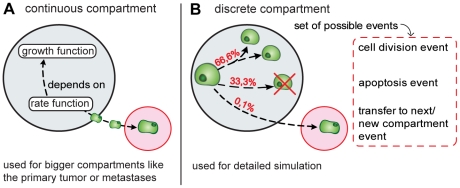Figure 1. Compartment types.
Compartments describe all parts that can contain malignant cells, such as primary tumour, blood stream or metastases and can be modelled in two different ways: In continuous compartments (A) all internal processes are represented by mathematical functions. The growth of the system is modelled via a growth function and the spread of metastases via a rate function. In a discrete compartment (B) all internal processes are modelled with the help of events. They describe what happens to a single cell at a specific time within the compartment. Events can be e.g. cell division, apoptosis, intravasation or the creation of a new metastasis and occur with an assigned probability in the compartment. Discrete compartments are used to simulate a compartment in detail. Continuous compartments are used to simulate bigger systems like the primary tumour or metastases.

